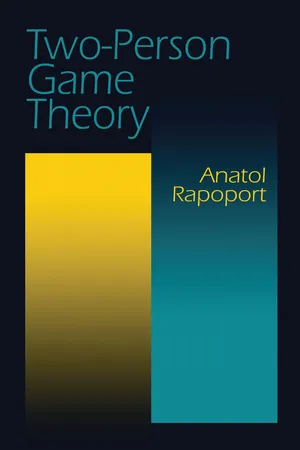
- 240 pages
- English
- ePUB (mobile friendly)
- Available on iOS & Android
Two-Person Game Theory
About this book
"Game theory is an intellectual X-ray. It reveals the skeletal structure of those systems where decisions interact, and it reveals, therefore, the essential structure of both conflict and cooperation." — Kenneth Boulding
This fascinating and provocative book presents the fundamentals of two-person game theory, a mathematical approach to understanding human behavior and decision-making, Developed from analysis of games of strategy such as chess, checkers, and Go, game theory has dramatic applications to the entire realm of human events, from politics, economics, and war, to environmental issues, business, social relationships, and even "the game of love." Typically, game theory deals with decisions in conflict situations.
Written by a noted expert in the field, this clear, non-technical volume introduces the theory of games in a way which brings the essentials into focus and keeps them there. In addition to lucid discussions of such standard topics as utilities, strategy, the game tree, and the game matrix, dominating strategy and minimax, negotiated and nonnegotiable games, and solving the two-person zero-sum game, the author includes a discussion of gaming theory, an important link between abstract game theory and an experimentally oriented behavioral science. Specific applications to social science have not been stressed, but the methodological relations between game theory, decision theory, and social science are emphasized throughout.
Although game theory employs a mathematical approach to conflict resolution, the present volume avoids all but the minimum of mathematical notation. Moreover, the reader will find only the mathematics of high school algebra and of very elementary analytic geometry, except for an occasional derivative. The result is an accessible, easy-to-follow treatment that will be welcomed by mathematicians and non-mathematicians alike.
Frequently asked questions
- Essential is ideal for learners and professionals who enjoy exploring a wide range of subjects. Access the Essential Library with 800,000+ trusted titles and best-sellers across business, personal growth, and the humanities. Includes unlimited reading time and Standard Read Aloud voice.
- Complete: Perfect for advanced learners and researchers needing full, unrestricted access. Unlock 1.4M+ books across hundreds of subjects, including academic and specialized titles. The Complete Plan also includes advanced features like Premium Read Aloud and Research Assistant.
Please note we cannot support devices running on iOS 13 and Android 7 or earlier. Learn more about using the app.
Information
11. An Example: Inspector vs. Evader
Table of contents
- DOVER BOOKS ON MATHEMATICS
- Title Page
- Copyright Page
- Preface
- Table of Contents
- 1Games
- 2. Utilities
- 3. Strategy
- 4. The Game Tree and the Game Matrix
- 5. Dominating Strategy and Minimax
- 6. Mixed Strategy
- 7. Solving the Two-Person Zero-sum Game
- 8. The Negotiated Game
- 9. Nonnegotiable Games
- 10. An Inductive Theory of Games: Dynamic Models
- 11. An Example: Inspector vs. Evader
- 12. Opportunities and Limitations
- Notes
- References
- Index